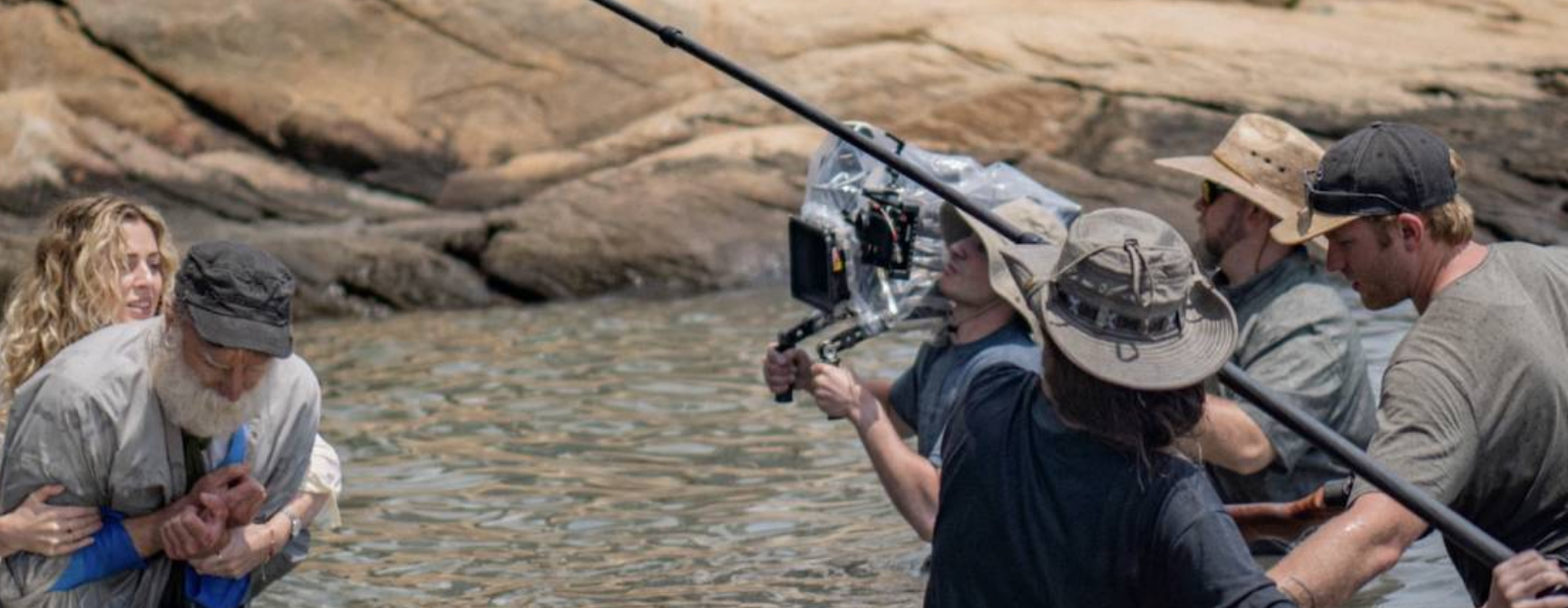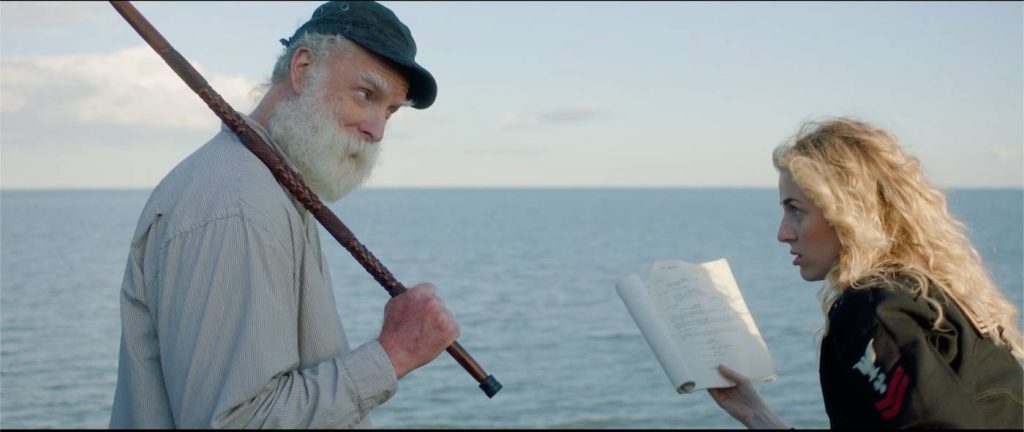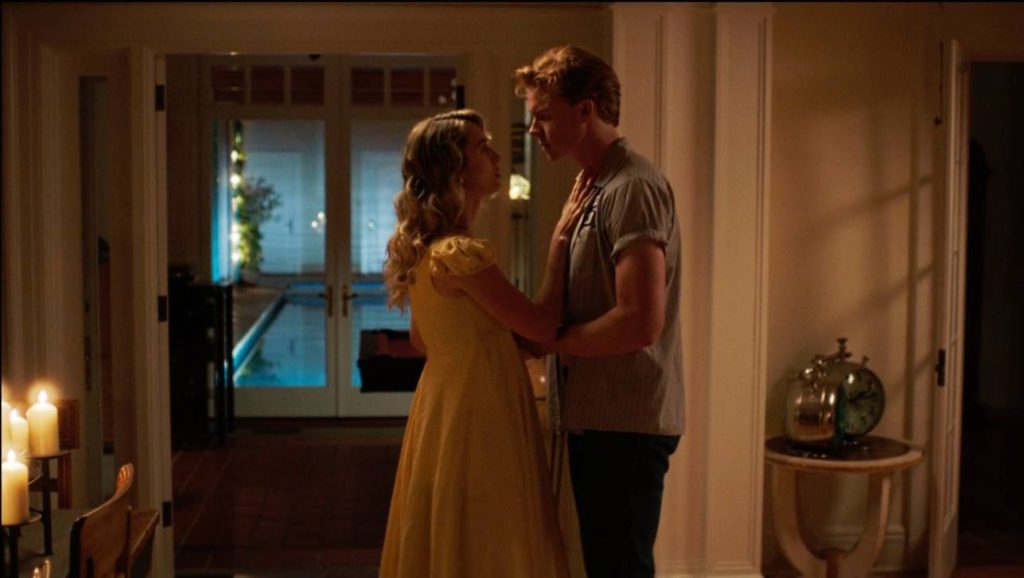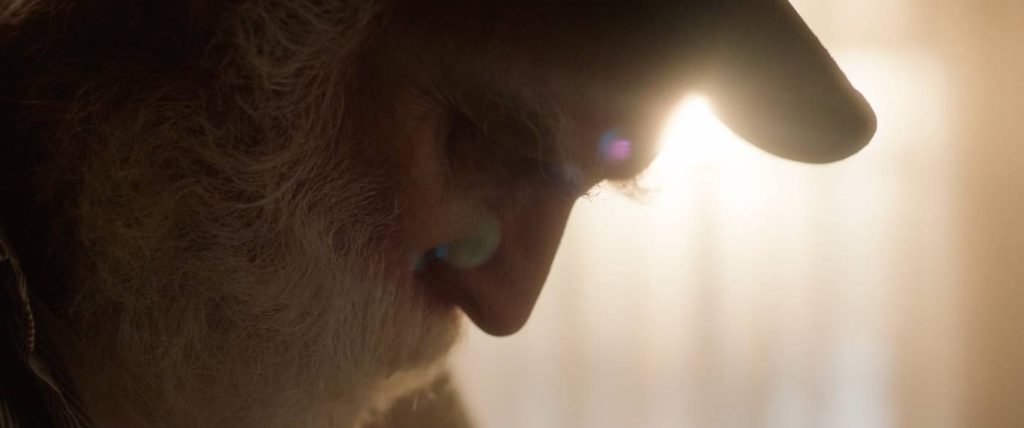
Dementia was part of writer-director Dillon Bentlage’s family, his grandmother struggling with its early stages before passing away from cancer. Watching Mr. Pearson is a love letter to those living with symptoms and the people around them wanting to give them their best life. The feature stars Hugo Armstrong as Robert Pearson, a former Hollywood legend battling mental decline. When one of his caregivers, Caroline (Dominika Zawada), finds out that performing scenes from his film work gives him new life, she stops at nothing to keep doing them.
“With my co-writer Simon [Kienitz Kincade], our goal was to try to make an indie movie that was poignant but not depressing. We wanted some people to maybe shed a tear, but we also wanted there to be a little bit of hope and happiness seeing these two characters build a relationship together,” Bentlage tells The Credits during a video call.
Bentlage and the tight-knit crew chose Guilford, Connecticut, to shoot the project for over 16 days, the majority of which was spent inside the Villa Louise, a historic home often visited by Buffalo Bill. “Paul Newman had lived a good portion of his life in Connecticut as well, so that kind of inspired the idea for the location and the idea of focusing on an older actor in his later years,” notes the director.
In making the movie, Bentalage says he wanted to challenge himself to finish in a shorter amount of time, as his last project took five years to finance and get off the ground. “We could have probably pushed to make it for a bigger budget, but there’s also a part of me that wants to take the chance on the people I know who are really talented. If that means making the movie for one-third of what the budget could have been, maybe that’s just the way the movie was supposed to be made.”
Below, the director talks about how he and the crew were able to pull off the film on a shoestring budget and tight schedule.

You and co-writer Simon Kincade wrote Caroline’s character specifically for actor Dominika Zawada. Did you also write for the Connecticut landscape?
We had a connection to the location of the main house, but we knew we would only have that location available for a certain time. It’s such an interesting-looking, unique, but not overly grand place that it made me really want to make something there and film on the water. It’s beautiful.
Was this your first time shooting in Connecticut?
It was my first time doing film work in Connecticut. I went to Boston University, and then, after finishing, I went to Amsterdam, where I lived for three and a half years to work on film there.
Did you work with Connecticut’s local film office?
Yes, the people at the film office were extremely friendly and very open to having us. Same for the town of Guilford, where we filmed. They were extremely friendly and open to having us. We went through all the proper lines of communications with the police department and the municipality of Guilford to make sure everything was kosher for us to do. Everyone in the town felt more excited knowing we were there which is I think rare compared to LA or New York where people can be just like, oh, another film.

Did you end up qualifying for Connecticut’s film tax incentive?
We did. The tax incentive is interesting because you have to hit a $100,000 minimum to qualify, which can be quite high if I’m being completely honest. Massachusetts is 25% with a $50,0000 minimum spend and New York has a $250,000 minimum spend in certain counties, otherwise it could be more. So, with Connecticut and the budget we spent, we were able to receive a 10% tax incentive. It’s great because we will have a little bit more budget to put back into post-production than we anticipated.
Since you had a limited production schedule, what went into the tech scouts?
As a director, I want to find people who are really opinionated, strong, love what they like, and own the project as if it’s their own. Because at the end of the day, it’s not my project, it’s everybody who worked on the project. So I left a lot of things in the hands of my production designer, Marie Marchant, and cinematographer Peter Nogueira. I was excited to see them execute their vision of what they saw when they read the script and what they wanted to get out of the location.
The largest set piece is Robert’s home. Did the team end up altering the existing space?
We took the furniture out and replaced it with other furniture. We also redesigned certain rooms for our needs. But the one thing we did was have a lot of the crew stay at that house, which was very unique to stay in a live set. We had to put live signs everywhere. But Marie is just so unbelievably talented. I don’t know if I’ve ever really met anyone who has her level of talent for this stuff and her memory of how everything looked and everything was beforehand. I got calls from the owners afterwards, just saying, it looked exactly the same, which is what you love to hear.
Were you and cinematographer Peter Nogueira able to storyboard the project?
We shot-listed and prepped for everything, but we were ready to change anything. You want to feel like you’re going in prepared, but you also need to be ready to maybe cut some shots and get down to the minimum. Every morning, we would all meet and do a little scrum to say, okay, this is how we are going to break up this day. But for the most part, we tried our best to stay true to what we had scheduled and definitely gave ample time to the crew to know what we were doing the next day. There’s nothing worse than coming to work and then everything is thrown on its head.

There’s an early scene where Robert and Caroline reenact lines from Robert’s acting career, and it whimsically transforms as if they are in a movie. How did that come together?
Peter is just a true artist, and I told him from the get-go that I was going to lean on him heavily to visually tell this story and to come up with ideas. I love that scene, and I think Peter nails the lens flare when that comes in. Then the score that composers Kyle Franklin and Jasper van Dijk created for it is just beautiful. There are these little clarinet whistles that remind you of an old nautical film. And then Dylan Castora’s sound design adds so much weight. Looking back at that scene, I am constantly amazed and so grateful for such an incredible team, and I feel like I found all the right people and let them kind of cook in a room together. They created something great.
How did you approach the sequence where Robert plays billiards with the younger version of himself?
That was one of the most difficult days, and I’m very thankful it came out great. We had a DJI Ronin setup, but that just did not do us justice. We ended up reshooting some of the scenes and hiring a Steadicam operator to really bring that home as best as we could.

Another alluring and moody scene is when Caroline dances with Robert. How did you pull that off?
The original idea of the dancing is very different from what we were eventually able to pull off. But we just thought of getting the choreographer in here. We’re going to teach him the dance, and we’re just going to film it over and over and over again until we can use something out of it. We didn’t do that for the billiard scene, there had to be a little bit more calculated, but the dance, just have them keep running it until we have enough to cut with.
Sean Baker’s Anora took home five Oscars on a $6 million budget at this year’s Academy Awards. How much does that inspire you as a filmmaker?
It does very much. It’s how I felt when American Fiction won for best adapted screenplay. Cord Jefferson made this speech about studios taking risks, and instead of making one $200 million dollar movie, try making 20 $10 million dollar movies or 50 $4 million dollar movies… It’s such an inspiration. And it’s so inspiring that Sean received such recognition for Anora. I don’t want to say that’s everyone’s goal but it’s nice to know that you don’t need to make a $250 million dollar movie to get that scale or that recognition.
You said in the film’s press notes that “in the pursuit of leaving a legacy, the most enduring legacy is one’s unwavering love for the craft.” What kind of legacy would you like to leave behind?
It’s been about almost 10 years since I finished school and I’m just constantly trying to push this journey. What I’ve come away learning or the legacy that I want to work on is to keep making movies. If it’s what you love doing, just do it. That’s the most important thing, right?
You can keep up with Watching Mr. Pearson via KT Pictures.
For more on filming in the Granite State, check out these stories:
Reel Returns: Connecticut’s Film Investment Fuels Economic Growth in a Competitive State of Play
How “One Royal Holiday” Was One Royal Savior for an Inn in Connecticut
How a Historic House in Connecticut Gave “Christmas on Honeysuckle Lane” the Perfect Location
Featured image: On the set of “Watching Mr. Pearson.” Courtesy KT Films.